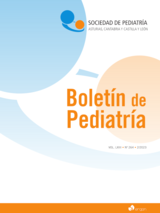Prevalencia de lactancia materna y factores asociados a su abandono en un área del centro-norte de España
M. Miñambres Rodríguez , L. Bermúdez Barrezueta , M. Palomares Cardador , I. Torres Ballester , P. López Casillas , A. Pino Vázquez
Bol. Pediatr. 2023; 63 (264): 104 - 113
Introducción. La lactancia materna (LM) es el alimento idóneo para el recién nacido y el lactante. El objetivo del estudio fue estimar la prevalencia y duración de la LM e identificar los factores relacionados con su abandono. Pacientes y métodos. Estudio observacional prospectivo, realizado en el Área de Salud Valladolid-Este, situada en el norte de España, que incluyó recién nacidos atendidos en la maternidad de un hospital de tercer nivel entre octubre de 2015 y febrero de 2016. Se excluyeron aquellos recién nacidos que precisaron ingreso hospitalario. Se llevaron a cabo encuestas a las madres al alta de maternidad y seguimiento mediante entrevistas telefónicas durante 2 años, realizadas a los 6, 12, 18 y 24 meses postparto, recogiéndose información sobre el tipo de alimentación de los recién nacidos, datos sociodemográficos, gestacionales y perinatales. Se realizó análisis de regresión de Cox, univariante y multivariante. Resultados. Se incluyeron 223 recién nacidos, 201 (90,1%) recibían LM al alta de maternidad (71,3% LM exclusiva y 18,8% lactancia mixta). La prevalencia de LM fue del 51,7% a los 6 meses, del 21,4% a los 12 meses y del 3% a los 24 meses. Los factores de riesgo relacionados con el abandono de la LM fueron: no haber amamantado previamente (HR 1,65; IC95% 1,13-2,42) o haber amamantado menos de 3 meses (HR 4,81; IC95% 2,32-9,25), tabaquismo materno gestacional (HR 2,57; IC95% 1,59-4,1), cesárea programada (HR 1,79; IC95% 1,08-2,98) y peso del recién nacido menor de 2.800 g (HR 1,57; IC95% 1,02-2,43). Conclusiones. La tasa de LM al alta de maternidad es similar a la de otros estudios nacionales. Se identificaron varios factores implicados en su abandono, hallazgos relevantes para diseñar estrategias de apoyo que permitan incentivar su continuidad.
Prevalence of breastfeeding and factors associated with cessation in an area of north-central Spain
Background. Breastfeeding (BF) is the optimal way to nourish newborns and infants, due to the multiple benefits it offers. The aim of this study was to estimate the prevalence and incidence of breastfeeding and identify the risk factors related with breastfeeding weaning. Methods. A prospective, observational study was performed on healthy newborns in the area of Valladolid-East, Spain, between October 2015 and February 2016. Questionnaires were completed by mothers at discharge from maternity and and follow-up through telephone interviews for 2 years, carried out at 6, 12, 18 and 24 months postpartum. Sociodemographic variables, gestational, perinatal and breastfeeding data were collected. Univariate and multivariate Cox regression analysis were performed. Results. A total of 223 newborns were included. At hospital discharge, 201 newborns (90.1%) received breastfeeding (71.3% exclusive breastfeeding and 18.8% partial breastfeeding). At 6 months, prevalence of breastfeeding was 51.7%, 21.4% at 12 months and 3% at 24 months. Risk factors for stopping breastfeeding were: not having previously breastfed (HR 1.65; IC95% 1.13-2.42) or previous breastfeeding less than 3 months (HR 4.81; IC95% 2.32-9.25), tobacco consumption during gestation (HR 2.57; IC95% 1.59-4.1), C-section without delivery work (HR 1.79; IC95% 1.08-2.98) and birthweight below 2,800 g (HR 1.57; IC95% 1.02-2.43). Conclusions. The rate of initiation of breastfeeding is similar to that of other national studies. Several risk factors related to the cessation of breastfeeding were identified. This is an important finding so as to design support strategies that will promote the maintenance of breastfeeding.
Artículo completo (PDF) (118 kb.)
- Gastroenterología
